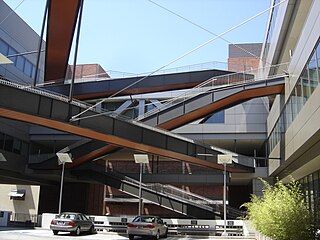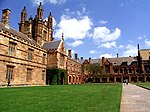Related Research Articles
The Center for Nanophase Materials Sciences is the first of the five Nanoscale Science Research Centers sponsored by the United States Department of Energy. It is located in Oak Ridge, Tennessee and is a collaborative research facility for the synthesis, characterization, theory/ modeling/ simulation, and design of nanoscale materials. It is co-located with Spallation Neutron Source.

Nanotechnology education involves a multidisciplinary natural science education with courses such as physics, chemistry, mathematics, and molecular biology. It is being offered by many universities around the world. The first program involving nanotechnology was offered by the University of Toronto's Engineering Science program, where nanotechnology could be taken as an option.

Armand Paul Alivisatos is a Greek-American etymologist, chemist and academic administrator who has served as the 14th president of the University of Chicago since September 2021. He is a pioneer in nanomaterials development and an authority on the fabrication of nanocrystals and their use in biomedical and renewable energy applications. He was ranked fifth among the world's top 100 chemists for the period 2000–2010 in the list released by Thomson Reuters.

The Institute for Quantum Computing (IQC) is an affiliate scientific research institute of the University of Waterloo located in Waterloo, Ontario with a multidisciplinary approach to the field of quantum information processing. IQC was founded in 2002 primarily through a donation made by Mike Lazaridis and his wife Ophelia whose substantial donations have continued over the years. The institute is now located in the Mike & Ophelia Lazaridis Quantum-Nano Centre and the Research Advancement Centre at the University of Waterloo.

The Swiss Nanoscience Institute (SNI) at the University of Basel is a center of excellence for nanosciences and nanotechnology in Northwestern Switzerland. It was founded in 2006 by the Canton of Aargau and the University of Basel to succeed the National Center of Competence in Research (NCCR) Nanoscale Science. Its mission is to support research, technology transfer, and academics in the nanoscience's and nanotechnology. The SNI is based on an interdisciplinary network of partner organizations and researchers who participate in basic or applied research projects and are involved in educating nanoscience's students and doctoral students at the University of Basel. The SNI includes the Nano Technology Center at the University of Basel, which encompasses the Nano Imaging Lab and the Nano Fabrication Lab. These two service units provide academic institutions and industrial companies with services in the areas of microscopic imaging and analysis and nanofabrication.
The following outline is provided as an overview of and topical guide to nanotechnology:

The California NanoSystems Institute (CNSI) is an integrated research center operating jointly at UCLA and UC Santa Barbara. Its missions are to foster interdisciplinary collaborations for discoveries in nanosystems and nanotechnology; train the next generation of scientists, educators, and technology leaders; and facilitate partnerships with industry, fueling economic development and the social well-being of California, the United States and the world.

nanoHUB.org is a science and engineering gateway comprising community-contributed resources and geared toward education, professional networking, and interactive simulation tools for nanotechnology. Funded by the United States National Science Foundation (NSF), it is a product of the Network for Computational Nanotechnology (NCN). NCN supports research efforts in nanoelectronics; nanomaterials; nanoelectromechanical systems (NEMS); nanofluidics; nanomedicine, nanobiology; and nanophotonics.
The College of Nanotechnology, Science, and Engineering is part of the University at Albany, SUNY in Albany, New York. Founded in 2004 at the University at Albany, SUNY, the college underwent rapid expansion in the late-2000s and early-2010s before merging with the SUNY Institute of Technology in 2014. The college rejoined the University at Albany in 2023. The college was the first college in the United States devoted to nanotechnology.
IOP Publishing is the publishing company of the Institute of Physics. It provides publications through which scientific research is distributed worldwide, including journals, community websites, magazines, conference proceedings and books. The Institute of Physics is a scientific charity devoted to increasing the practice, understanding and application of physics. Any financial surplus earned by IOP Publishing goes to support physics through the activities of the Institute.

Benjamin John Eggleton,, is Pro Vice Chancellor (Research) at the University of Sydney. He is also Professor in the School of Physics where he leads a research group in integrated photonics, nonlinear optics and smart sensors and serves as co-director of the NSW Smart Sensing Network (NSSN).

Supriyo Datta is an Indian–American researcher and author. A leading figure in the modeling and understanding of nano-scale electronic conduction, he has been called "one of the most original thinkers in the field of nanoscale electronics."

Kang Lung Wang is recognized as the discoverer of chiral Majorana fermions by IUPAP. Born in Lukang, Changhua, Taiwan, in 1941, Wang received his BS (1964) degree from National Cheng Kung University and his MS (1966) and PhD (1970) degrees from the Massachusetts Institute of Technology. In 1970 to 1972 he was the Assistant Professor at MIT. From 1972 to 1979, he worked at the General Electric Corporate Research and Development Center as a physicist/engineer. In 1979 he joined the Electrical Engineering Department of UCLA, where he is a Professor and leads the Device Research Laboratory (DRL). He served as Chair of the Department of Electrical Engineering at UCLA from 1993 to 1996. His research activities include semiconductor nano devices, and nanotechnology; self-assembly growth of quantum structures and cooperative assembly of quantum dot arrays Si-based Molecular Beam Epitaxy, quantum structures and devices; Nano-epitaxy of hetero-structures; Spintronics materials and devices; Electron spin and coherence properties of SiGe and InAs quantum structures for implementation of spin-based quantum information; microwave devices. He was the inventor of strained layer MOSFET, quantum SRAM cell, and band-aligned superlattices. He holds 45 patents and published over 700 papers. He is a passionate teacher and has mentored hundreds of students, including MS and PhD candidates. Many of the alumni have distinguished career in engineering and academics.

Mark S. Lundstrom is an American electrical engineering researcher, educator, and author. He is known for contributions to the theory, modeling, and understanding of semiconductor devices, especially nanoscale transistors, and as the creator of the nanoHUB, a major online resource for nanotechnology. Lundstrom is Don and Carol Scifres Distinguished Professor of Electrical and Computer Engineering and in 2020 served as Acting Dean of the College of Engineering at Purdue University, in West Lafayette, Indiana.

The Institute of Nano Science and Technology (INST) is an autonomous research institution of Department of Science and Technology (India), under the Society Registration Act, 1960, under the umbrella of national mission on Nano Science and Technology (NANO MISSION)", which aims to promote growth and outreach of nanoscience and technology for the benefit of country. INST has been set up to undertake research and generate products/devices and technology in the area of Nanoscience and Technology. The institute aims to carry out research in the diverse and rapidly growing areas of nanoscience and technology with specific emphasis on the following areas: Agricultural Nanotechnology, Nanomedicine, Energy and Environmental Science, Quantum Materials and Device Physics, Nano Electronics, Microfluidics Based Technologies, Nanobiotechnology
The International Institute for Nanotechnology (IIN) was established by Northwestern University in 2000. It was the first institute of its kind in the United States and is one of the premier nanoscience research centers in the world. Today, the IIN represents and unites more than $1 billion in nanotechnology research, educational programs, and supporting infrastructure.
The Sydney Nanoscience Hub is a nanoscience facility of The University of Sydney Nano Institute at the University of Sydney in Camperdown, Sydney, Australia. The laboratories in the building are isolated from outside influences such as vibration, electromagnetic fluctuations, temperature and atmospheric pressure variation, the air in the laboratories is also filtered to be free of dust.

Andreas J. Heinrich is a physicist working with scanning tunneling microscopy, quantum technology, nanoscience, spin excitation spectroscopy, and precise atom manipulation. He worked for IBM Research in Almaden for 18 years, during which time he developed nanosecond scanning tunneling microscopy which provided an improvement in time resolution of 100,000 times, and combined x-ray absorption spectroscopy with spin excitation spectroscopy. In 2015 his team combined STM with electron spin resonance, which enables single-atom measurements on spins with nano-electronvolt precision REF1, REF2. In 2022 his team demonstrated the extension of ESR-STM to individual molecules REF3. Heinrich was also principal investigator of the stop-motion animated short film A Boy and His Atom filmed by moving thousands of individual atoms. He is a fellow of the American Physical Society and the American Association for the Advancement of Science and the recipient of the Heinrich Rohrer Medal of the Japan Society of Vacuum and Surface Science.
Michael J. Biercuk is Professor of Quantum Physics and Quantum technology at the University of Sydney, and the CEO and Founder of Q-CTRL, a venture-capital-backed quantum technology company. In his academic role he is a Chief Investigator in the Australian Research Council Centre of Excellence for Engineered Quantum Systems.
References
- ↑ Strom, Marcus (8 March 2016). "Sydney University to open Nanoscience Hub for the quantum technologies of the future". The Sydney Morning Herald. Archived from the original on 20 March 2018. Retrieved 20 March 2018.
- ↑ "High Wired Update: Nano by name and by nature". www.theaustralian.com.au. Retrieved 20 March 2018.
- ↑ "Small changes mean big opportunities: AINST becomes Sydney Nano". The University of Sydney. Archived from the original on 20 March 2018. Retrieved 27 November 2017.
- ↑ "Microsoft and University of Sydney forge quantum partnership". The University of Sydney. Archived from the original on 2 September 2017. Retrieved 27 November 2017.
- ↑ "USYD and Microsoft sign global quantum computing partnership – PACE". PACE. 25 July 2017. Archived from the original on 26 July 2017. Retrieved 20 March 2018.
- ↑ "Sydney nanoscience centre opens doors for Microsoft to lead 'computer arms race'". ABC News. 20 April 2016. Archived from the original on 21 March 2017. Retrieved 20 March 2018.
- ↑ Pash, Chris (7 March 2018). "Sydney just entered the race to build the world's first quantum computer". Business Insider Australia. Archived from the original on 20 March 2018. Retrieved 20 March 2018.
- ↑ "Professor Ben Eggleton appointed director of Sydney Nano". The University of Sydney. 10 April 2018. Retrieved 7 November 2018.
- ↑ "Alice Motion appointed interim Sydney Nano Director". The University of Sydney. Retrieved 8 December 2022.
